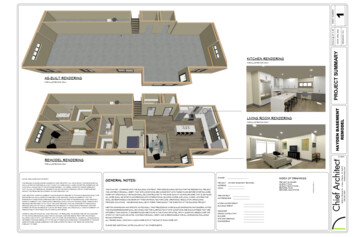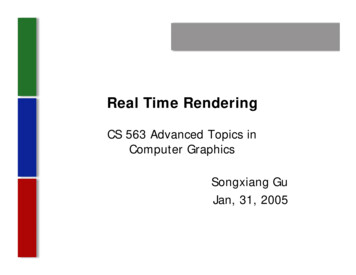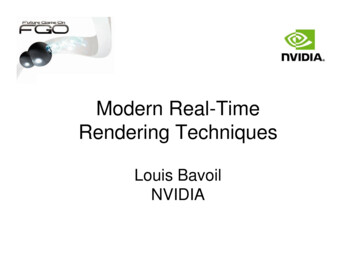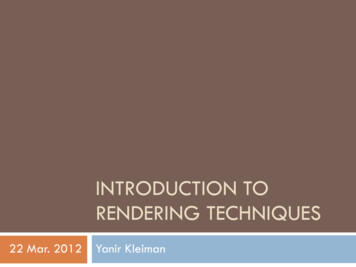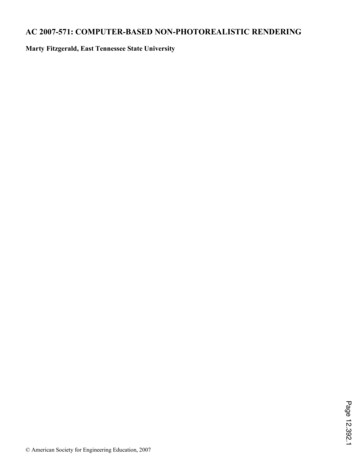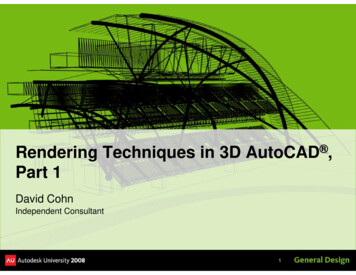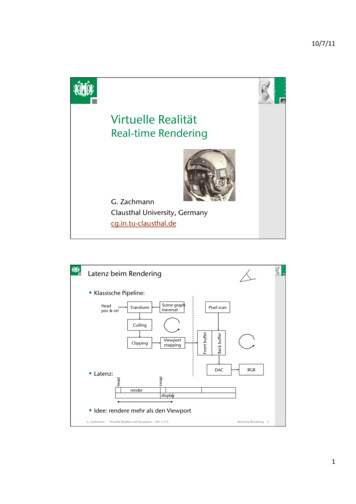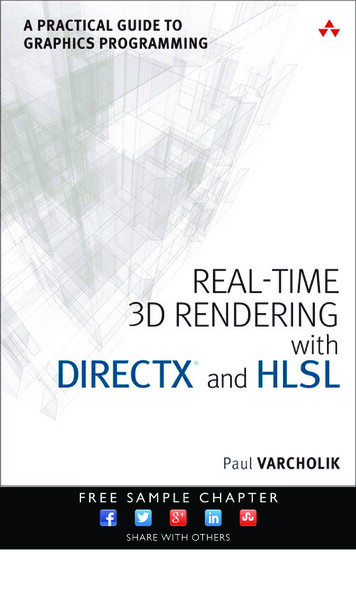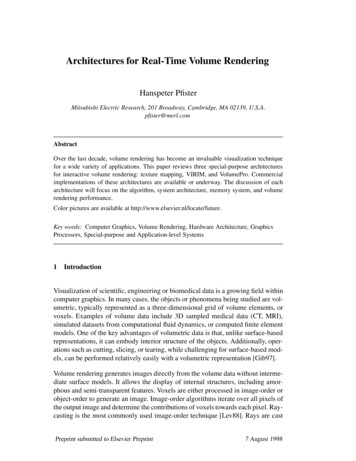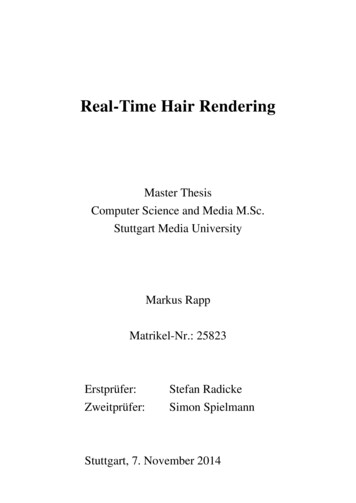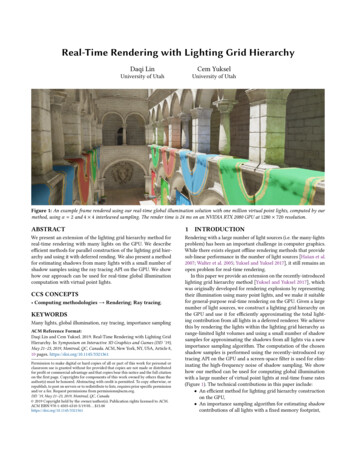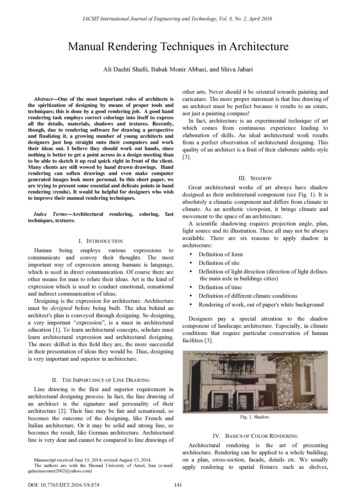
Transcription
IACSIT International Journal of Engineering and Technology, Vol. 8, No. 2, April 2016Manual Rendering Techniques in ArchitectureAli Dashti Shafii, Babak Monir Abbasi, and Shiva Jabariother arts. Never should it be oriented towards painting andcaricature. The more proper statement is that line drawing ofan architect must be perfect because it results to an estate,not just a painting compass!In fact, architecture is an experimental technique of artwhich comes from continuous experience leading toelaboration of skills. An ideal architectural work resultsfrom a perfect observation of architectural designing. Thisquality of an architect is a fruit of their elaborate subtle style[3].Abstract—One of the most important roles of architects isthe spiritization of designing by means of proper tools andtechniques; this is done by a good rendering job. A good handrendering task employs correct colorings into itself to expressall the details, materials, shadows and textures. Recently,though, due to rendering software for drawing a perspectiveand finalizing it, a growing number of young architects anddesigners just hop straight onto their computers and worktheir ideas out. I believe they should work out hands, sincenothing is better to get a point across in a design meeting thanto be able to sketch it up real quick right in front of the client.Many clients are still wowed by hand drawn drawings. Handrendering can soften drawings and even make computergenerated images look more personal. In this short paper, weare trying to present some essential and delicate points in handrendering (rendu). It would be helpful for designers who wishto improve their manual rendering techniques.Index Terms—Architecturaltechniques, textures.rendering,coloring,III. SHADOWfastI. INTRODUCTIONHuman being employs various expressions tocommunicate and convey their thoughts. The mostimportant way of expression among humans is language,which is used in direct communication. Of course there areother means for man to relate their ideas. Art is the kind ofexpression which is used to conduct emotional, sensationaland indirect communication of ideas.Designing is the expression for architecture. Architecturemust be designed before being built. The idea behind anarchitect's plan is conveyed through designing. So designing,a very important “expression”, is a must in architecturaleducation [1]. To learn architectural concepts, scholars mustlearn architectural expression and architectural designing.The more skilled in this field they are, the more successfulin their presentation of ideas they would be. Thus, designingis very important and superior in architecture.Great architectural works of art always have shadowdesigned as their architectural component (see Fig. 1). It isabsolutely a climatic component and differs from climate toclimate. As an aesthetic viewpoint, it brings climate andmovement to the space of an architecture.A scientific shadowing requires projection angle, plan,light source and its illustration. These all may not be alwaysavailable. There are six reasons to apply shadow inarchitecture:yyyyyyDefinition of formDefinition of siteDefinition of light direction (direction of light definesthe main axle in buildings cities)Definition of timeDefinition of different climate conditionsRendering of work, out of paper's white backgroundDesigners pay a special attention to the shadowcomponent of landscape architecture. Especially, in climateconditions that require particular conservation of humanfacilities [3].II. THE IMPORTANCE OF LINE DRAWINGLine drawing is the first and superior requirement inarchitectural designing process. In fact, the line drawing ofan architect is the signature and personality of theirarchitecture [2]. Their line may be fair and sensational, sobecomes the outcome of the designing, like French andItalian architecture. Or it may be solid and strong line, sobecomes the result, like German architecture. Architecturalline is very dear and cannot be compared to line drawings ofFig. 1. Shadow.IV. BASICS OF COLOR RENDERINGArchitectural rendering is the art of presentingarchitecture. Rendering can be applied to a whole building;on a plan, cross-section, facade, details etc. We usuallyapply rendering to spatial fixtures such as shelves,Manuscript received June 15, 2014; revised August 13, 2014.The authors are with the Shomal Universty of Amol, Iran (e-mail:galaxiescomet2002@yahoo.com)DOI: 10.7763/IJET.2016.V8.874141
IACSIT International Journal of Engineering and Technology, Vol. 8, No. 2, April 2016projections, hollows and so on [4].To express the mood of environment, unfixed furniture isused, such as table and chair; there is no need in fullcoloring (see Fig. 2). A technical way of rendering is toshow large or big components without coloring. Largesurfaces like ground, water and sky need no specific color.To show water without the use of color, you can draw areflection.building's surfaces, because:yyyit reduces the use of colormaterials are employed to functions, climate andecosystem of the estateit harmonizes the estateTo draw various materials, one should be highly creativein genesis of diverse textures. This kind of creativity comesfrom a keen observation of materials and abstract sketchingof them. Such designing knowledge and skill comes toarchitects as a result of drawing diverse textures whichbelong to different climate conditions [5].VII. ARCHITECTURAL RENDERING TECHNIQUESRendering is a technique which is done by any tool if onehas the knowledge of coloring and applying the correct rules;in fact, rendering means the better presentation of one work.Architectural rendering techniques include magic marker,water-color, colored pencil, normal pencil, charcoal, pastel,water-ink, match-ink, linear rendering, tea, bleach, dry/freshblack marker, dry colored marker, scrubber, correction fluid,white roller-ball pen, acetone.Fig. 2. Color rendering.VIII. MAGIC MARKER RENDERINGMagic marker can be used to color (paint) surfaces andplanes in a rendering sheet. It also can be used to drawvarious textures on planes [5]. For magic marker renderingyou should first outline the plan by a red pencil (because itcan be mixed with marker’s color), then after finishing theoutline, the direction of light must be defined. In this styleof rendering, you render minor surfaces instead of coloringlarge surfaces (e.g. glasses, water ).Using ink-pen and white roller-ball pen to draw materialson various surfaces, makes your work more seasoned.Fig. 3. Texture.First, one should imagine correctly, then apply a correctcolor; then architecturally render the sheet. Varioustechniques for rendering exist; one of the professional toolsfor architectural rendering is the magic marker technique.IX. WATER-INKV. THE DIFFERENCE BETWEEN ARCHITECTURE AND THEART OF PAINTING/GRAPHICSLines and borders are very dear in architecture. Coloring isa means to define surfaces, the atmosphere, and theseparation of planes between lines. In painting and graphics,borders are defined by colors. In fact, color acts as line forpainting and graphics.VI. TEXTUREThere exist various solutions to present components of abuilding such as plan, facade, cross-section and perspective.It depends upon the architect's creativity and knowledge tochoose from, e.g. coloring and collage-making [4].A crucial part of architectural designing is to choosematerial and the right type of it in the right place (see Fig. 3).The most technical way of projecting these elements is todraw the building materials with regard to climate,ecosystem and time. This is superior to mere coloring of142This is the one of the most professional rendering styles;it uses different tones of a same color on different surfacesof an architecture to express it [6].This tool can be used easily to create any texture, and toshow the light and its direction. Colors are usual on abuilding and the use of brown, indigo and black is usual inthis kind of rendering. It is important to choose and use aquality ink for this style (see Fig. 4). This rendering usuallyis done on large sheets on which an application of colorcontrasts makes the design more attractive to eyes.Also in this technique, you should sketch by a smoothpencil, so that the sketch can be removed easily at the endand the result becomes more natural; in this manner themost beautiful skies and waters can be drawn [6].X. MONOTONE BLACK RENDERINGThis is one of the fastest professional rendering styles(see Fig. 5). Its application is comparable to water-inktechnique. Due to high color-contrast, this style is very
IACSIT International Journal of Engineering and Technology, Vol. 8, No. 2, April 2016attractive in terms of visuals. White roller-ball pen can beused easily to draw materials and textures on the surfaces ofthis rendering.application of scream-colors results to a more attractivework.Fig. 7. Monotone rendering by magic marker.Fig. 4. Water-ink.XIII. WATER-COLORDue to numerous varieties of colors and facility ofcombining, this is one of the best rendering tools. It is usedfor more realistic illustrations; the quality of the water-colorin use is of significant importance [6]. The more quality ofthe water-color be, the sooner its colors shall be dried andmat.XIV. MATCH RENDERINGFig. 5. Monotone black rendering.XI. LINEAR RENDERINGThis is a fast rendering style which uses minimum toolsand means at the best timing to show any target on abuilding architecture (see Fig. 6). Use this rendering stylewhen defining many textures; and also when you are goingto define light direction on the architecture’s different layers,providing the observation of line density.Lines in this style are porous and hollow, so they gain aspecific importance. For the nature of this style, surfacesacquire a filled-blank pattern, as if the planes are made ofpiled match sticks [7].For the purpose of this style, a 2mm mechanical pencil isused. Match stick is stripped using a cutter. Then, as a lead,it is driven into the mechanical pencil’s leadholder. Aquality ink (with a specific color) is selected, thenmatchhead soaked with the ink gives you a kind of brush.Use it to draw your design on the sheet.XV. BLEACHBleach rendering can be operated on a colored card stock.A bleach removes paper’s color and gives it a white orbrighter color (see Fig. 8). Bleach can be mixed with variouscolors to create a specific color. Combination of bleach withdifferent amounts of water, gives different color intensities.It is applied on the card using a brush; other tools like whiteink, magic marker and roller-ball pen can be used too. To dothis you should outline the primary work on a sheet (cardstock) by a pencil, then begin to render it using brush andbleach [7].Fig. 6. Linear rendering.XII. MONOTONE RENDERING BY MAGIC MARKER(EXCLUDING BLACK MARKER)Be audacious! Choose only one color among markers andlet go of others (see Fig. 7). Draw your work by pencil orroller-ball pen, and then define the direction of light. Beginwith coloring of darker layers, that is back-lighted layers,and then go through brighter layers like ceiling, floor, andfront-lighted layers. Re-coloring of darker layers by themarker, gives you more intense colors. Usually, anFig. 8. Bleach rendering.143
IACSIT International Journal of Engineering and Technology, Vol. 8, No. 2, April 2016Pen among them, is slightly different, because both itspowder and solid forms can be employed (see Fig. 11).though the solid form is a more professional approach. Eyeshadow should be of the dry and non-rosemary kind.XVI. RENDERING INDOOR PERSPECTIVEWhen working on indoor perspectives, sometimes it isneeded to show them in a better way or to express theirspatial dimensions. Then it comes to perspective rendering.There are some techniques and tools to do this (see Fig. 9)This first step normally deals with coloring of sequences todefine the depth of space. Large surfaces like floor, ceiling,and walls should not be rendered much, because the useof color increases and the work becomes a painting.XVIII. COMPOSITE RENDERINGMost creative rendering works are made up of severaltechniques and tools that are combined and presented in anartistic fashion. To do this you should master morerendering applications and qualities (see Fig. 12). Whenbigger sheets are needed for a work, or it comes to diversity,you as an architect can use combination of methods [8].Fig. 9. Indoor perspective.To decrease the use of color, light direction should bedefined and shadows of different objects on floor andsurfaces should be drawn. Some effects like reflection onthe floor and glasses give a more vivid semblance to thework.Fig. 12. Composite rendering.XVII. PEN, PASTEL, EYE-SHADOW RENDERINGXIX. RENDERING OF FAÇADETo use such tools you should be very careful, firstlybecause they need to be fixed on paper, and secondlybecause the expressive power delivered by them isn’t muchlike marker or water-color rendering [8] (see Fig. 10). Theyare used for fast rendering and are very handy andaccessible.These tools are used merely to render sky or largesurfaces in many occasions.Architectural lines are technical components, so in façaderendering you shouldn’t deteriorate them when designing.Drawing of sky and trees is allowed in non-technicalrendering, but for the purpose of technical rendering,drawing trees and sky – just for beatifying motives – is notappropriate [9].Technical rendering methods in architecture includeshadowing, drawing ground, drawing various textures,drawing soft shadows, inclusion of very abstract shapes offigures and trees without any color and just for scaling,defining glasses as transparent element XX. RENDERING OF SITE PLANThe purpose of this rendering is to define the plan in abetter and more understandable fashion; usually site iscolored more detailed, but on rendering a site plan, don’tinvolve yourself with colors, because it shall take you muchtime. On technical rendering of plan, don’t use color insideof it, let there be completely clean and white. At most, youcan apply shadows to walls [9]. Render around the plan sothat it project itself. For minimum use of color and increasedreadability, don’t apply colors to both routs and spacesbetween; color just one of them. White segments of workleads to a more attractive and breathy product.For site rendering you can use a monotone color or aselection of scream colors. That is personal and notobligatory to choose what types of colors. When a plan isdefined as a component of sketch sheet, it should berendered in harmony with the whole sheet and its elements.Fig. 10. Eye-shadow rendering.Fig. 11. Pastel rendering.144
IACSIT International Journal of Engineering and Technology, Vol. 8, No. 2, April 2016[8]XXI. CONCLUSIONA good architectural rendering job which is smart andelaborate (and is considerate about lines, shadows, coloringrules, color psychology, textures, various renderings likefaçade, plan and site) gives spirit to your work and ispleasing to the sight of observers. Always be careful andloyal to rendering basics and rules so as to present a correctand professional rendering job.[9]Ali Dashti Shafii was borin in Iran, 1949. Herecevied his PhD. in architecture venice, Italy in1976, he is a professional urban planner, Venice,Italy in 1977, he has been worked over forty yearsof professional architectural experience.Hepublished with over 100 papers (including 40 ISIessays).An authenticated author of urbanplanning: the author of modern planning, buildinga project, fiber carbon for quake-resistance.REFERENCES[1][2][3][4][5][6][7]M. M. Mahmoodi and K. Taghizadeh, “Information Technology andInstructional changes in Architectural engineering,” presented at theNational Instructional Conference on Engineering, Iran, Tehran, 1999.H. Karimi, “Teaching architectural drawing through informationtechnology,” presented at the National Conference on Urban Planningand Architecture, Iran, Tabriz, April, 2012.E. Tayefe, How to draw architecturally 1, Elme Memar Institution,2008, ch. 5, pp. 98-99.E. Tayefe, How to draw architecturally 2, Elme Memar Institution,2009, ch. 2.E. Tayefe, How to draw architecturally 3, Elme Memar Institution,2010, pp. 44-45.Q. Akrami, “The introduction section of previous book,” in How todram How to draw architecturally 3, E. Tayefe, Ed. 2010.H. R. Derakhshan, “Drawing skills tutural and its role in Architecturaldrawing” presented at the third National Architecture conference,Iran, March 15-16, 2013.E. K. Motlagh, “Creativing in architectural form and methods ofcreativing development,” presented at the international conference ofCivil Engineering and Architecture, Iran, 2013.S. Gheishavizade and A. R. Taghizadeh, “Use of software: a newapproach in architectural drawing,” presented at the first nationalconference on Urban Planning and Architecture across times, Iran,Tehran, 2013.Babak Monir Abbasi holds master of architecture from Shabestar, Iranand he teaches at different universities such as Parand Payam Noor, ParandIslamic Azad University. Now he is working with Dr. Dashti on someproject. He as an assistant.Miss Shiva Jabari was born in Iran, 1992. She is a scholar at ShomalUnivevrsity of Amol, Iran. She has good English language skills, She hasworked as the corresponding author and she is Mr. Dashti’s editorialassistant. She mainly works as a translator and editor.145
Using ink-pen and white roller-ball pen to draw materials on various surfaces, makes your work more seasoned. IX. WATER-INK This is the one of the most professional rendering styles; it uses different tones of a same color on different surfaces of an architecture to express it [6]. T
